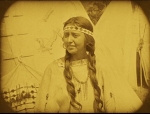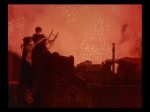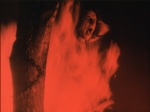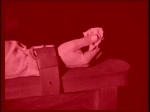Regular readers have probably guessed already that I am obsessed with color in early film. While Technicolor and hand-color get a lot of attention, I wanted to take time to celebrate the workhorses of silent movie color: tinting and toning.
The vast majority of all silent films had at least some sequences of color and most of that color came from tinting and toning. The techniques could set the mood, help tell the story or just help soften the black and white film. Due to technological issues, tinting pretty much died in mainstream Hollywood pictures after the coming of sound, though there were some notable exceptions, such as the sepia in The Sea Hawk and The Wizard of Oz.
I should mention that tinting and toning are generally referred to collectively as tinting. Basically, tinting is for the whites while toning colors the blacks of film. The two techniques could be combined for a double color effect, which you will see below.
Okay, my lovelies, my goal here is to collect as many shades and tones in silent movie screencaps as possible. We’re making a nitrate rainbow! Ready?
(Roll over image to see the film’s title.)
Note that many of these shots are from films with restored or digitally enhanced color. Just FYI.
This post is part of the Classic Movie History Project. Read the other posts because they are fab!









































Definitely don’t taste it. My review of the 1929-30 sewage treatment pilot test facility project in Griffith Park indicates that the film processing waste from the First National Studios in Burbank were a bit of a problem…
It is confirmed, if you find a piece of nitrate film, do not eat it! Repeat, do not eat it!
My father used to tell me (when I was a young tyke) about how much fun it was when nitrate film caught on fire… the fumes/smoke were toxic and the fires were hard to put out.
Yep, a rather nasty substance all around.
Lovely! Just so you know, the title for “The Blue Bird” isn’t popping up for me (using Firefox on a Windows 7 machine).
All fixed!
Don’t Like Tinted Silent Movies
Whelp, most of them are tinted so looks like you are just plain out of luck ¯\_(ツ)_/¯
Toning of motion pictures, from what I can find on the web, was a chemical process and used some of the agents that I have used for still photography prints:
“gold, selenium, uranium, lead, cobalt, platinum, iron, cobalt chloride, lead acetate, lead nitrate, lead oxalate, palladium chloride, uranium nitrate and vanadium chloride” (OVEREXPOSURE: Health Hazards in Photography – Susan D Shaw)
Toxic? Hell yeah! Awful for the environment? Yep.
Some would have been and still are very expensive: gold, platinum and palladium particularly so.
It’s poison! Let’s slather it all over everything! 😉 Someday, I will have to share my research on the way tints were marketed and what they were meant to represent. It is adorable!
Your mosaic is very attractive, perhaps Movies Silently Enterprises should consider making a poster version for sale.
Thank you kindly!
Love the rainbow, don’t taste the rainbow:) love the looks and it just shows how alive silent films are
Indeed! Thank you
You really did make a rainbow! Gorgeous!!
Thank you so much!
Fritzi, I have a question for you. I recorded a film from TCM years ago, which was unfortunately destroyed. The film starred Gloria Swanson and was, I believe, filmed completely in two strip Technicolor! The setting was in olden days , I believe in England. There were many beautiful scenes which involved cliffs and seascape. Would you happen to know what film that was?
Fritzi,
I forgot to ask if you might, perhaps, know where it would be possible to obtain color versions of all of those swashbuckling films that Ted Turner created and premiered on his network years ago? There were no silent in there, but I thought that you might know.
I’ve never had cable so I’m afraid I’m not much help in this regard.
I know there were color sequences in Stage Struck but I’m not sure if it was ever aired on TCM.
How fun! AND an important refresher for me before I head to Capitolfest. I LOVE galleries, which you may know, and this one is beautiful.
Aurora
Thank you so much!
Hi Fritzi. The rainbow is a wonderful idea. With my super-8 movies, I tried to achieve non-toxic tinting with filters, but it was too hard to keep up with the scene changes. I think the first time I saw a silent film tinted was when our local PBS station ran the Killiam collection Saturday (?) nights.
Very cool idea! Yeah, tinting was gorgeous but…
I knew The Blue Bird had to make two appearances: it’s just so beautiful!
Fritzi, thanks fro co-hosting this event again. Reading the posts is even better than going to film school.
Kisses!
Thanks so much! Yeah, The Blue Bird is one of the most gorgeous films ever made! 🙂